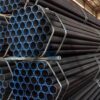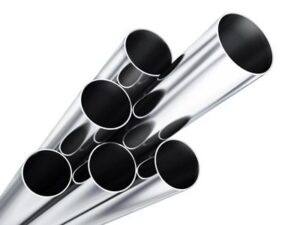Description
ASTM A335 Alloy Steel Pipes: A Comprehensive Guide to Applications and Properties
ASTM A335 is a widely recognized standard specifying seamless alloy steel pipes intended for high-temperature service. These pipes are often found in power generation, petrochemical processing, and other industries where resistance to heat and pressure is paramount. Choosing the correct A335 grade is crucial for ensuring the safety and efficiency of these critical applications. This article provides a comprehensive overview of ASTM A335 alloy steel pipes, covering their key properties, common grades, applications, and considerations for selection.
What is ASTM A335?
ASTM A335 defines the standard specification for seamless ferritic alloy-steel pipes used for high-temperature services. The “seamless” designation signifies the absence of a weld seam along the pipe’s length, contributing to its superior strength and resistance to failure under extreme conditions. The inclusion of alloying elements, primarily chromium (Cr) and molybdenum (Mo), significantly enhances the pipe’s creep resistance, oxidation resistance, and overall high-temperature performance.
Key Properties and Benefits:
- High-Temperature Strength: A335 pipes excel in maintaining their strength and integrity at elevated temperatures, crucial for applications involving superheated steam or hot process fluids.
- Creep Resistance: The alloy composition provides exceptional resistance to creep, the gradual deformation of a material under sustained stress at high temperatures.
- Oxidation Resistance: Chromium additions impart resistance to oxidation, preventing scaling and degradation of the pipe surface in high-temperature environments.
- Corrosion Resistance: Certain A335 grades with higher chromium content offer improved resistance to corrosion in specific environments.
- Weldability: A335 pipes are generally weldable, allowing for flexibility in fabrication and installation. However, proper welding procedures, including preheating and post-weld heat treatment, are often required to maintain the material’s integrity.
- Seamless Construction: The absence of a weld seam eliminates a potential weak point, leading to greater reliability and safety in high-pressure applications.
Common A335 Grades and Their Uses:
The ASTM A335 standard encompasses various grades, each with a unique alloy composition and corresponding properties. Some of the most popular grades include:
- P1: This is the most basic grade, containing 0.5% chromium and 0.5% molybdenum. It is commonly used in lower-temperature, lower-pressure applications within the petrochemical industry.
- P5: Contains 4-6% chromium and 0.5% molybdenum. P5 offers improved corrosion resistance and is frequently used in refinery applications, especially in sulfur-containing environments.
- P9: Contains 8-10% chromium and 1% molybdenum. P9 provides further enhanced corrosion and oxidation resistance compared to P5, making it suitable for more demanding applications in power generation and petrochemical industries.
- P11: Contains 1.25% chromium and 0.5% molybdenum. This grade offers a good balance of strength, creep resistance, and weldability, making it a versatile option for various high-temperature applications.
- P22: Contains 2.25% chromium and 1% molybdenum. P22 is a widely used grade offering excellent high-temperature strength and creep resistance, commonly employed in power plants for superheater and reheater tubes.
- P91: A more advanced grade containing 9% chromium, 1% molybdenum, vanadium, and niobium. P91 offers significantly improved creep strength compared to P22, allowing for higher operating temperatures and pressures, leading to greater efficiency in power generation.
Applications of ASTM A335 Alloy Steel Pipes:
The exceptional properties of A335 pipes make them ideal for a wide range of demanding applications, including:
- Power Generation: Superheater and reheater tubes in boilers, main steam lines, and other high-temperature components in power plants.
- Petrochemical Industry: Process piping, heat exchangers, and reactor vessels in refineries and chemical plants.
- Oil and Gas Industry: Transportation of high-temperature fluids and gases, particularly in downstream processing facilities.
- High-Temperature Furnaces: Components within industrial furnaces operating at elevated temperatures.
Considerations for Selecting the Right A335 Grade:
Choosing the appropriate A335 grade requires careful consideration of several factors, including:
- Operating Temperature and Pressure: The intended operating temperature and pressure dictate the required strength and creep resistance of the pipe.
- Fluid Composition: The chemical composition of the fluid being transported or contained can influence the corrosion resistance requirements.
- Code Requirements: Compliance with applicable industry codes and standards (e.g., ASME, API) is essential.
- Welding Procedures: The chosen grade’s weldability and the availability of qualified welding procedures need to be considered.
- Cost: Different A335 grades have varying costs, and the optimal balance between performance and cost should be evaluated.
Conclusion:
ASTM A335 alloy steel pipes offer a reliable and robust solution for high-temperature fluid transport and containment. By understanding the properties of various A335 grades and carefully considering the specific application requirements, engineers and designers can select the appropriate pipe material to ensure the safe, efficient, and long-lasting performance of critical industrial systems. The meticulous selection and application of ASTM A335 are paramount in industries demanding the highest levels of reliability and performance under extreme conditions.

















Reviews
There are no reviews yet.